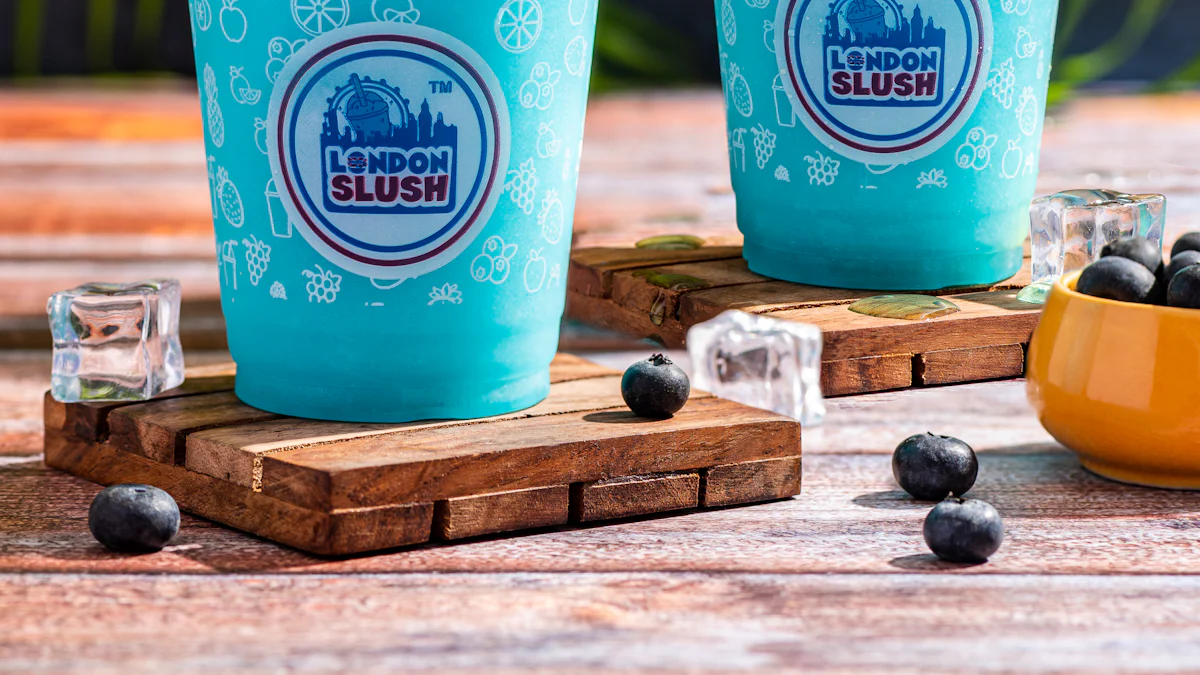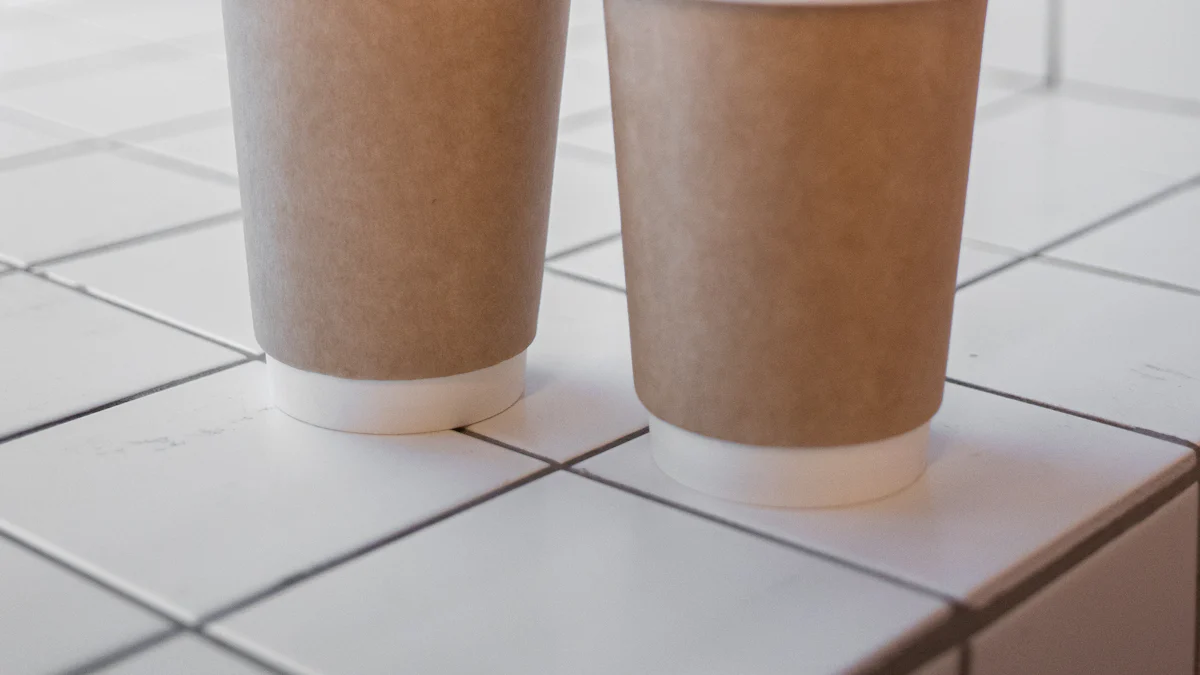
Choosing the right cup with lid supplier plays a vital role in business success. I’ve seen how quality suppliers ensure consistent product standards and build consumer trust. They also help businesses avoid costly recalls and disruptions. Partnering with sustainable suppliers boosts reputations, reduces waste, and fosters innovation. Every purchase should align with your goals.
Key Takeaways
- Pick suppliers who use good materials and have safety approvals. This builds trust and ensures reliable products.
- Look for suppliers offering custom cups and lids. These can promote your brand and attract more customers.
- Check if suppliers care about the environment. Green choices appeal to eco-friendly buyers and help your brand look better.
Exploring Types of Disposable Cups and Lids

Materials Overview: Plastic, Paper, and Biodegradable Options
When choosing disposable cups and lids, I always consider the material first. Each type has unique advantages. Here’s a quick comparison:
| Material | Advantages |
|---|---|
| PET | Lightweight, strong, impact-resistant, and recyclable. |
| Poly-Coated | Stable, smooth, moisture-resistant, available in single or double layers for durability. |
| Wax-Coated | Leak-resistant, strong, and sturdy, ideal for cold applications. |
For eco-conscious businesses, biodegradable options stand out. Bagasse lids, for example, decompose within 30-90 days and return natural ingredients to the environment. These are perfect for reducing plastic waste while maintaining functionality. I’ve noticed that biodegradable cups also enrich soil when composted, making them a sustainable choice.
Lid Varieties: Flat, Dome, and Sip-through Designs
Lid designs play a crucial role in functionality. I’ve found that flat lids work best for hot beverages. They minimize spills and make transport easier. Dome lids, on the other hand, are ideal for frothy drinks like lattes or milkshakes. They provide extra space for toppings and enhance the drink’s visual appeal. Sip-through lids cater to convenience, allowing customers to enjoy their drinks without removing the lid. Each design serves a specific purpose, so I always match the lid type to the beverage being served.
Customization for Branding and Marketing
Customized cups and lids can transform your business. They act as mini billboards, boosting brand visibility both inside and outside your establishment. I’ve seen how creative designs spark conversations and enhance customer engagement. Custom branding also conveys professionalism, helping businesses establish trust. While customization may involve additional costs, the long-term benefits for brand recognition and customer loyalty make it a worthwhile investment.
Tip: Partnering with the right cup with lid supplier ensures access to high-quality materials and customization options that align with your branding goals.
Key Considerations When Choosing a Cup with Lid Supplier

Ensuring Material Quality and Food Safety Standards
I always prioritize material quality and food safety when selecting a supplier. Disposable cups and lids must meet strict standards to ensure they are safe for food and beverages. Certifications like the BRCGS Global Standard for Packaging Materials and AA Grade Certification guarantee high hygiene and safety levels. Here’s a quick overview of key certifications:
| Certification Standard | Key Features |
|---|---|
| BRCGS Global Standard | Ensures material quality and food safety for disposable cups and lids. |
| AA Grade Certification | Indicates high hygiene and food safety standards. |
| Food Safety Culture | Promotes a holistic approach to food safety across the organization. |
These certifications help me trust that the products meet industry standards and protect my customers.
Evaluating Cost-Effectiveness and Bulk Pricing
Cost plays a major role in supplier selection. I’ve found that purchasing in bulk often reduces unit costs, saving money over time. For example, ordering disposable paper cups with lids in large quantities ensures I can meet customer demand while keeping expenses low. However, I always consider hidden costs like shipping and storage to calculate the total return on investment. A reliable cup with lid supplier offers competitive pricing without compromising quality.
Prioritizing Environmental Sustainability
Sustainability has become a top priority for many businesses. I look for suppliers offering eco-friendly options like strawless PET cups, recyclable lids, and biodegradable plastics. These materials reduce waste and align with global efforts to eliminate single-use plastics. Paper cups with paper lids are another excellent choice. They break down naturally, reducing landfill waste and enhancing brand image. Adopting sustainable materials not only benefits the environment but also attracts eco-conscious customers.
Assessing Customization Services for Branding
Customized cups and lids are essential for branding. I always check if a supplier provides high-quality printing and design options. A good supplier helps me create visually appealing products that showcase my brand. Customization enhances customer experience and builds brand recognition. It’s a powerful marketing tool that turns everyday items into promotional assets.
Verifying Supplier Reputation and Reliability
A supplier’s reputation speaks volumes about their reliability. I conduct background checks and review their history to ensure they deliver consistent quality. References from other clients provide valuable insights into their performance. I also evaluate their delivery performance, including on-time rates and flexibility. Financial stability is another key factor. A dependable cup with lid supplier ensures smooth operations and long-term partnerships.
Steps to Evaluate and Negotiate with Suppliers
Researching and Shortlisting Reliable Suppliers
When I start evaluating suppliers, I focus on finding those who align with my business values. I look for suppliers offering eco-friendly products and customization options. Reviews and recommendations help me gauge their reputation. I also verify their credentials and certifications to ensure they meet quality and safety standards. Requesting samples allows me to assess product durability firsthand. Comparing pricing structures helps me balance cost and quality. Responsiveness and communication are equally important. A supplier who communicates well ensures smoother operations. Sustainability practices and certifications also play a big role in my decision-making process.
Tip: Always research supplier testimonials and industry feedback to avoid potential risks.
Requesting Samples to Assess Product Quality
Samples give me a clear picture of what to expect. I use scorecards to evaluate suppliers against specific criteria like material quality and durability. Checking certifications ensures the products meet industry standards. I also assess production capabilities early to avoid surprises later. Samples help me confirm that the supplier can deliver consistent quality, which is crucial for maintaining customer satisfaction.
Comparing Pricing, Delivery, and Terms
I always start by identifying my needs, including the required quality, quantity, and delivery time. Then, I request detailed quotes from multiple suppliers. This helps me compare the total cost of ownership (TCO), which includes hidden costs like shipping and storage. Delivery performance is another critical factor. I evaluate on-time delivery rates, flexibility, and lead times. Reviewing shipping options and tracking systems ensures transparency in logistics. These steps help me find a supplier who balances cost, reliability, and efficiency.
| Factor | Description |
|---|---|
| Delivery Performance | Measures the reliability of suppliers through On-Time Delivery Rate (OTD). |
| Flexibility | Ability of suppliers to adapt to changes in specifications or demand. |
| Lead Time | The duration from order placement to delivery, impacting production planning and inventory. |
Negotiating Favorable Terms and Building Partnerships
Preparation is key to successful negotiations. I research supplier capabilities, market trends, and pricing structures to craft informed proposals. I focus on creating value beyond pricing, such as faster delivery times or better service levels. Inviting multiple suppliers to submit proposals fosters competition, encouraging them to offer their best terms. Building long-term partnerships also benefits my business. Strong relationships improve communication, enhance trust, and create opportunities for joint growth. For example, a reliable cup with lid supplier can offer exclusive products or better pricing for bulk orders, helping me manage costs effectively.
Note: Flexibility during negotiations often leads to better outcomes. Be open to compromise to build lasting partnerships.
Choosing the right cup with lid supplier requires careful evaluation. I always focus on understanding material types, ensuring quality, and prioritizing sustainability. Defining business needs and researching suppliers are essential steps. Strong partnerships with reliable suppliers enhance brand reputation, reduce risks, and drive innovation. Start with suppliers to align your goals with long-term success.
Tip: Ask about sustainable options, quality control, and client references to ensure reliability.
FAQ
What certifications should I look for in a supplier?
I always check for certifications like BRCGS and AA Grade. These ensure food safety and material quality. Reliable suppliers display these certifications prominently.
How can I verify a supplier’s reputation?
I review client testimonials and industry feedback. I also request references from other businesses. This helps me confirm their reliability and service quality.
Why is sustainability important when choosing a supplier?
Sustainability reduces environmental impact and attracts eco-conscious customers. I prioritize suppliers offering biodegradable or recyclable options to align with global efforts to reduce waste.
Post time: Jan-29-2025




